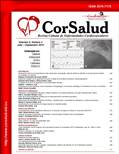Progressive development of giant J wave and extreme prolongation of QT interval in induced hypothermia
Abstract
The appearance of J waves is the most common event observed in the electrocardiogram of a patient with hypothermia. We report the case of 47 years-old man, who underwent cardiac arrest using hypothermia for cardiac surgery. In the electrocardiographic tracing the progressive development of giant J waves is evident. These waves can mimic acute myocardial infarction and are considered a predictor of arrhythmogenesis.Downloads
References
1. Aslam AF, Aslam AK, Vasava-da BC, Khan IA. Hypothermia: evaluation, electrocardiogra-phic manifestations, and ma-nagement. Am J Med. 2006; 119(4):297-301.
2. Mattu A, Brady WJ, Perron AD. Electrocardiographic ma-nifestations of hypothermia. Am J Emerg Med. 2002;20(4): 314-26.
3. Kanna B, Wani S. Giant J wave on 12-lead electro-cardiogram in hypothermia. Ann Noninvasive Elec-trocardiol. 2003;8(3):262-65.
4. de Souza D, Riera AR, Bombig MT, Francisco YA, Brollo L, Filho BL, et al. Electrocardiographic changes by accidental hypothermia in an urban and a tro-pical region. J Electrocardiol. 2007;40(1):47-52.
5. Lassning E, Maurer E, Nöemeyer R, Eber B. Osborn
wave and incessant ventricular fibrillation during therapeutic hypothermia. Resucitation. 2010;81(4): 500-1.
6. Haisaguerre M, Derval N, Sacher F, Jesel L, Deisen-hofer I, de Roy L, et al. Sudden cardiac arrest asso-ciated with early repolarization. N Eng J Med. 2008; 358(19):2016-23.
Downloads
Published
How to Cite
Issue
Section
License
Authors who publish with this journal agree to the following terms:- Authors retain copyright and grant the journal right of first publication with the work simultaneously licensed under a Creative Commons Attribution License that allows others to share the work with an acknowledgement of the work's authorship and initial publication in this journal.
- Authors are able to enter into separate, additional contractual arrangements for the non-exclusive distribution of the journal's published version of the work (e.g., post it to an institutional repository or publish it in a book), with an acknowledgement of its initial publication in this journal.










